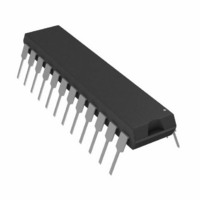AD7731BNZ Analog Devices Inc, AD7731BNZ Datasheet - Page 22

AD7731BNZ
Manufacturer Part Number
AD7731BNZ
Description
IC ADC 24BIT SIGMA-DELTA 24DIP
Manufacturer
Analog Devices Inc
Datasheet
1.AD7731BRUZ.pdf
(44 pages)
Specifications of AD7731BNZ
Data Interface
DSP, Serial, SPI™
Number Of Bits
24
Sampling Rate (per Second)
6.4k
Number Of Converters
1
Power Dissipation (max)
125mW
Voltage Supply Source
Analog and Digital
Operating Temperature
-40°C ~ 85°C
Mounting Type
Through Hole
Package / Case
24-DIP (0.300", 7.62mm)
Resolution (bits)
24bit
Sampling Rate
6.4kSPS
Input Channel Type
Single Ended
Supply Voltage Range - Analog
4.75V To 5.25V
Supply Voltage Range - Digital
2.7V To 5.25V
Lead Free Status / RoHS Status
Lead free / RoHS Compliant
For Use With
EVAL-AD7731EBZ - BOARD EVALUATION FOR AD7731
Lead Free Status / RoHS Status
Lead free / RoHS Compliant, Lead free / RoHS Compliant
AD7731
Event
Power-On Reset
RESET Pin
STANDBY Pin
Mode 011 Write
SYNC Pin
Mode 000 Write
Conversion or
Cal Mode Write
Clock 32 1s
Data Register Read
CIRCUIT DESCRIPTION
The AD7731 is a sigma-delta A/D converter with on-chip digital
filtering, intended for the measurement of wide dynamic range,
low-frequency signals such as those in strain-gage, pressure
transducer, temperature measurement, industrial control or pro-
cess control applications. It contains a sigma-delta (or charge-
balancing) ADC, a calibration microcontroller with on-chip
static RAM, a clock oscillator, a digital filter and a bidirectional
serial communications port. The part consumes 13.5 mA of
power supply current with a standby mode which consumes
only 20 A. The part operates from a single +5 V supply. The
clock source for the part can be provided via an external clock
or by connecting a crystal oscillator or ceramic resonator across
the MCLK IN or MCLK OUT pins.
The part contains three programmable-gain fully differential
analog input channels which can be reconfigured as five pseudo-
differential inputs. The part handles a total of seven different
input ranges on all channels which are programmed via the on-
chip registers. The differential unipolar ranges are: 0 mV to
+20 mV through 0 V to +1.28 V and the differential bipolar
ranges are: 20 mV through 1.28 V.
The AD7731 employs a sigma-delta conversion technique to
realize up to 24 bits of no missing codes performance. The
Set Registers
to Default
Yes
No
No
No
No
No
No
No
Yes
Mode
Bits
000
000
As Is
011
As Is
000
New
Value
As Is
As Is
Table XVII. Reset Events
Filter
Reset
Yes
Yes
Yes
Yes
Yes
Yes
Initial
Reset
No
No
–22–
sigma-delta modulator converts the sampled input signal into a
digital pulse train whose duty cycle contains the digital informa-
tion. A digital low-pass filter processes the output of the sigma-
delta modulator and updates the data register at a rate that can
be programmed over the serial interface. The output data from
the part is accessed over this serial interface. The cutoff fre-
quency and output rate of this filter can be programmed via on-
chip registers. The output noise performance and peak-to-peak
resolution of the part varies with gain and with the output rate
as shown in Tables I to IV.
The analog inputs are buffered on-chip, allowing the part to
handle significant source impedances on the analog input. This
means that external R, C filtering (for noise rejection or RFI
interference reduction) can be placed on the analog inputs if
required. The common-mode voltage range for the analog in-
puts comes within 1.2 V of AGND and 0.95 V of AV
reference input is also differential and the common-mode range
here is from AGND to AV
The AD7731 contains a number of hardware and software
events that set or reset status flags and bits in registers. Table
XVII summarizes which blocks and flags are affected by the
different events.
Analog
Power-Down
Yes
No
Yes
Yes
No
No
No
No
No
Reset Serial
Interface
Yes
No
No
No
No
No
No
Yes
Yes
DD
.
Set RDY
Pin/Bit
Yes
Yes
Yes
Yes
Yes
Yes
Yes
Yes
Yes
DD
No
Set STDY
Bit
Yes
Yes
Yes
Yes
Yes
Yes
Yes
Yes
. The
REV. A
REV. 0












